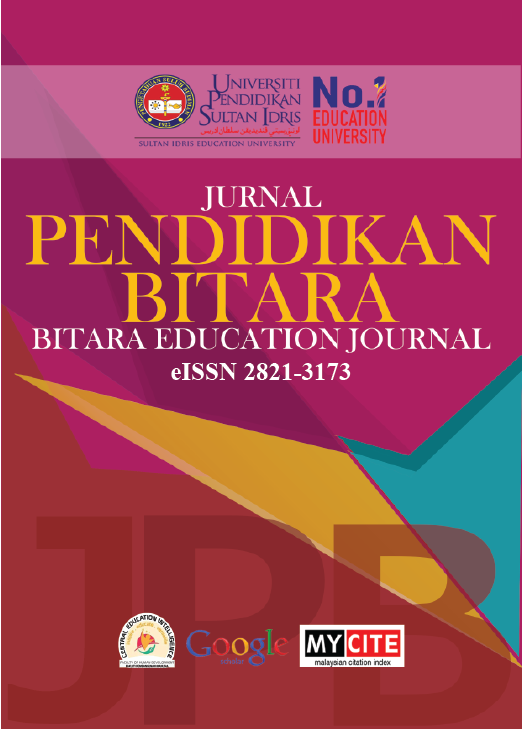Relationship of Scientific Creativity and Problem Solving Physics of Form Four students
Hubungan Kreativiti Saintifik dan Penyelesaian Masalah Fizik pelajar tingkatan empat
DOI:
https://doi.org/10.37134/bitara.vol14.2.4.2021Keywords:
scientific creativity, physics problem solvingAbstract
Scientific creativity is involved in Physics problem solving and it is an important element in problem solving. Mastery of scientific creatisvity is essential because it enable higher order thinking and improve problem solving. However, not many studies are found on scientific creativity in Physics problem solving. Hence, this research was conducted to study the relationship between scientific creativity and Physics problem solving. The research involved 30 Form 4 students from Bandar Tenggara, Johor to answer several open-ended questions. The instrument used to measure scientific creativity is the Scientific Structure Creativity Model (SSCM) while the Minnesota Assessment of Problem Solving (MAPS) is used to measure Physics problem solving. The results show that the students have a moderate level of scientific creativity and low level of Physics problem solving ability. There exists a positive and significant correlation between scientific creativity and Physics problem solving with the value of r = 0.371 and p = 0.044. As a conclusion, the positive and significant relationship between scientific creativity and Physics problem solving should be seen by educators as the reason to give emphasis in strengthening creativity among the students as a means to improve the students’ ability to solve Physics problems.
Downloads
References
Aktamis, H., & Ergin, O. (2008) The Effect of Scientific Process Skills Education on Students’ Scientific Creativity, Science Attitudes and Academic Achievements.o Asia-Pacific Forum on Science Learning and Teaching, 9(1), 1-21.
Amalia, Y., Sukarmin, & Suharno. (2020) Analysis of Student's Creative Thinking Skills Profiles On Work and Energy Topics. AIP Conference Proceedings. 2296, 1-020107.
Buhungo, T. J., & Probowo, T. P. (2016) Description of Problem Solving Ability Students in Physics Lesson. International Seminar on Science Education (ISSE) 2016, 480.
Coughlan, A. (2007) Learning to learn: Creative thinking and critical thinking, DCU Student Learning Resources, Office of the Vice-President for Learning Innovation and Registrar.
De Corte, E., Verschaffel, L., & Schrooten, H. (1992) Cognitive Effects of Learning to Program in Logo: A One-Year Study with Sixth Graders. Berlin: Springer-Verlag.
Dhir, T. E. E. N. A. (2014) Problem Solving Ability and Science Process Skills as The Influential Factors of Scientific Creativity. International Journal of Research Pedagogy and Technology in Education Movement Sciences, 2(4), 11-17.
Docktor, J., & Heller, K. (2009) Robust Assessment Instrument for Student Problem Solving. Proceedings of the NARST 2009 Annual Meeting, Garden Grove, CA. 1-19.
Erdener, N. (2003) Developing Creative Thinking-Design and Predictive Ability in Education.
Gaigher, E., Rogan, J. M., & Braun, M. W. H. (2007) Exploring the Development of Conceptual Understanding through Structured Problem‐solving in Physics. International Journal of Science Education, 29(9), 1089-1110.
Hoover, S. M., & Feldhusen, J. F. (1990) The Scientific Hypothesis Formulation Ability of Gifted Ninth-Grade Students. Journal of Educational Psychology, 82(4), 838.
Hu, W., & Adey, P. (2002) A Scientific Creativity Test for Secondary School Students. International Journal of Science Education, 24(4), 389-403.
J. L. Docktor. (2016) Assessing Student Written Problem Solutions: A Problem-Solving Rubric with Application to Introductory Physics. Phys. Rev. Phys. Educ, 12(1).
Koray, Ö. (2003) Influence of Creative Thinking Based Learning in Science Education On Learning Products. PhD Thesis, Gazi University, Institute of Social Sciences, Ankara.
Lin, C., Hu, W., Adey, P., & Shen, J. (2003) The Influence of Case on Scientific creativity. Research in ScienceEducation, 33, 143-162.
Mohamed, A. H. (2006) Investigating the Scientific Creativity of Fifth-Grade Students. PhD Thesis, University of Arizona.
Mohd Noor Badlilshah Bin Abdul Kadir, Mohd Mustamam Abdul Karim & Nurulhuda Abd. Rahman (2016). Sikap Pelajar Terhadap Pembelajaran Fizik dan Hubungannya dengan Pencapaian dalam Kalangan Pelajar Sains. Jurnal Personalia Pelajar, 19(1), 23-38.
Mohtar, Lilia & Halim, Lilia. (2015) Konstruk Kreativiti Saintifik Bagi Kajian Dalam Pendidikan Fizik Sekolah Menengah: Satu Sorotan Literatur. Sixth International Conference on Science and Mathematics Education. November 16-19,2015. Pulai PinangVolume: RECSAM, 1-17
Mukhopadhyay, R. (2013) Measurement of Creativity in Physics-A Brief Review on Related Tools. Journal of Humanities and Social Science, 5, 4550.
Mukhopadhyay, R., & Sen, M. K. (2013) Scientific Creativity-A New Emerging Field of Research: Some Considerations. International Journal of Education and Psychological Research, 2(1), 1-9.
Ornek, F. (2009) Problem Solving: Physics Modeling-Based Interactive Engagement. Asia-Pacific Forum on Science Learning and Teaching, 10(2), 1-35.
Pekmez, E. S., Aktamıs, H., & Taskın, B. C. (2009) Exploring Scientific Creativity of 7 Th Grade Students. Journal of Qafqaz University. 26.
Phang, F. A. (2010). Patterns of Physics Problem-solving and Metacognition among Secondary School Students: A Comparative Study between the UK and Malaysian Cases. The International Journal of Interdisciplinary Social Sciences, 5(8), 309-324.
Redish, E. F. (2003) Teaching Physics: With The Physics Suite. Hobokon NJ: John Wiley & Son.
S. Handajani, H. Pratiwi, and M. Mardiyana. (2018) The 21st Century skills with Model Eliciting Activities on Linear Program. J. Phys. Conf. Ser. 1008(1).
Simamora, R. E., Sidabutar, D. R., & Surya, E. (2017) Improving Learning Activity and Students’ Problem Solving Skill Through Problem Based Learning (PBL) in Junior High School. International Journal of Sciences: Basic and Applied Research (IJSBAR), 33(2), 321-331.
Šorgo, A. (2012) Scientific Creativity: The Missing Ingredient in Slovenian Science Education. European Journal of Educational Research, 1(2), 127-141.
Wahi, H., & Sulaiman, S. (2007) Penguasaan Penyelesaian Masalah Fizik Mengikut Model Heller Dan Hubungannya Dengan Pencapaian Penyelesaian Masalah Fizik Pelajar Tingkatan 4. Ph.D. Thesis, Universiti Teknologi Malaysia.
Yahaya Buntat & Noor Sharliana Mat Nasir (2011). Faktor-Faktor Yang Mendorong Kreativiti Di Kalangan Pelajar, Universiti Teknologi Malaysia. Journal of Educational Psychology and Counseling, 2, 175-208.
Yuliana, I., Priyadi, R., Zulhadi, Z., Kaslam, K., & Mahruf, M. (2020) Students’ Problem-Solving Abilities in Temperature and Heat Topic. 1st Annual Conference on Education and Social Sciences (ACCESS 2019),107-110.
Zewdie, Z. M. (2014) An Investigation of Students' Approaches to Problem Solving in Physics Courses. International Journal of Chemical and Natural Science, 2, 77-89.





